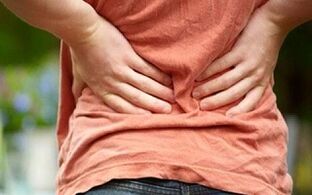
We’re sure you’ve read and heard that low back osteochondrosis often affects bank employees and office workers, developers, and representatives of hard physical labor. This is true, but the whole truth is that today it is difficult to find at least one type of activity that is not associated with the risk of developing this disease.
Why is that? Osteochondrosis of the sacrum is a type of "tax on upright walking, " a tribute that each of us must pay to nature. The reason for the degenerative changes in the cartilaginous tissue of the intervertebral disc lies not so much in the increased loads of its nucleus pulposus, but in the peculiarities of the blood supply to these structures.
By about the age of 20, the arteries that feed the fibrocartilage tissues of IVD in adolescence have been cleared, and for all the remaining years the nucleus pulposus and annulus fibrosus receive nutrients exclusively by diffusion, and this is clearly not enough! Trace elements, polysaccharides, amino acids and other structural components enter chondrocytes (cells that synthesize the interstitial substance of the disc) in extremely limited quantities, which creates fertile ground for the development of dystrophic processes.
During professional activities we regularly throw seeds into this fertile soil. We sit in the wrong position, lift weights incorrectly, move a little and spend a lot of time behind the wheel or behind a computer monitor. Among all other circumstances, this form of physical activity "eludes us", but in conditions of limited supply of cartilaginous structures in IVD, degenerative processes inevitably develop.
How does osteochondrosis of the lower back manifest itself?
The first manifestation of osteochondrosis of the lumbar region is the pain syndrome. As a rule, the "lucky one" is hit for the first time by a sharp pain in the back that pierces his body with a dagger. The pain occurs after inadvertently twisting the torso, tilting or after hypothermia. bed.
What changes occur on the spinal column in the background of the pain syndrome? To reduce pain, the nervous system sends stimulus signals to the deep muscles of the back. Strengthening muscle tone helps reduce the mobility of the affected segment of the spine, which reduces the severity of pain for a while. In the future, myofixation ceases to perform a compensatory function, and such a muscular-tonic imbalance only intensifies the pain.
When examining such a patient, the neuropathologist will detect signs of fixation syndrome or objective symptoms of the disease - changes in statics and dynamics. By changes in the statics of osteochondrosis of the lower back we mean the smoothing or intensification of physiological curvature (lordosis) and the appearance of pathological curvature towards pain (scoliosis). The dynamic symptoms of the disease are a sharp restriction of mobility (up to complete immobilization) in the affected segment.
All these changes can be confirmed by spondylography (X-ray of the spine) and more modern research methods such as computed tomography and MRI. The images also show a decrease in disc height in the area of clinically significant PDS, hernial protrusion, osteophyte.
Osteochondrosis of the lower back, treatment
The fixation and pain syndrome combined with the morphological signs on the diagnostic images form a complete picture of the vertebral syndrome caused by osteochondrosis of the lower back. The next question we ask the doctor after the end of the diagnostic phase is how to treat the disease?
Of course, it is not always the disease that needs to be cured, but the patient, but we will not move away from philosophical discussions. And we will solve more urgent problems - we will first have to overcome the pain syndrome. To do this, we need drugs of systemic and local action, such as NSAIDs, corticosteroid hormones, muscle relaxants, and perhaps even antidepressants. After the pain syndrome is relieved, it is time for conservative treatment methods.
If you have been diagnosed with low back osteochondrosis, the treatment will be long and you should be prepared for it both morally and financially. De facto and de jure it is impossible to completely overcome the disease, so you will have to visit doctors with a certain frequency until the end of your days.
The treatment algorithm is always individual, and it was developed by a doctor who knows the history of the disease, we will only list the possible directions of therapy. Reflexology has a positive effect, among the methods of which acupuncture is in the first place. Some experts advocate traction therapy, although other schools of vertebrology deny this technique. It is worth trying massage therapy, you should definitely include back exercises (LFK) in your rehabilitation program, you can also resort to the help of qualified chiropractors.
In 90 cases out of 100 methods of conservative therapy are sufficient to bring the disease under control, the remaining ten patients are indicated for surgical treatment. In the absence of absolute indications for surgery (severe spondylolisthesis, spinal stenosis), treatment with minimally invasive surgery is possible. If the degree of morphological changes in the spine has reached a critical level, modern methods of disc reconstruction using implants are used.























